Biden is furious at allegations that Israel is using starvation as a weapon of war. But he is complicit in Gaza’s famine
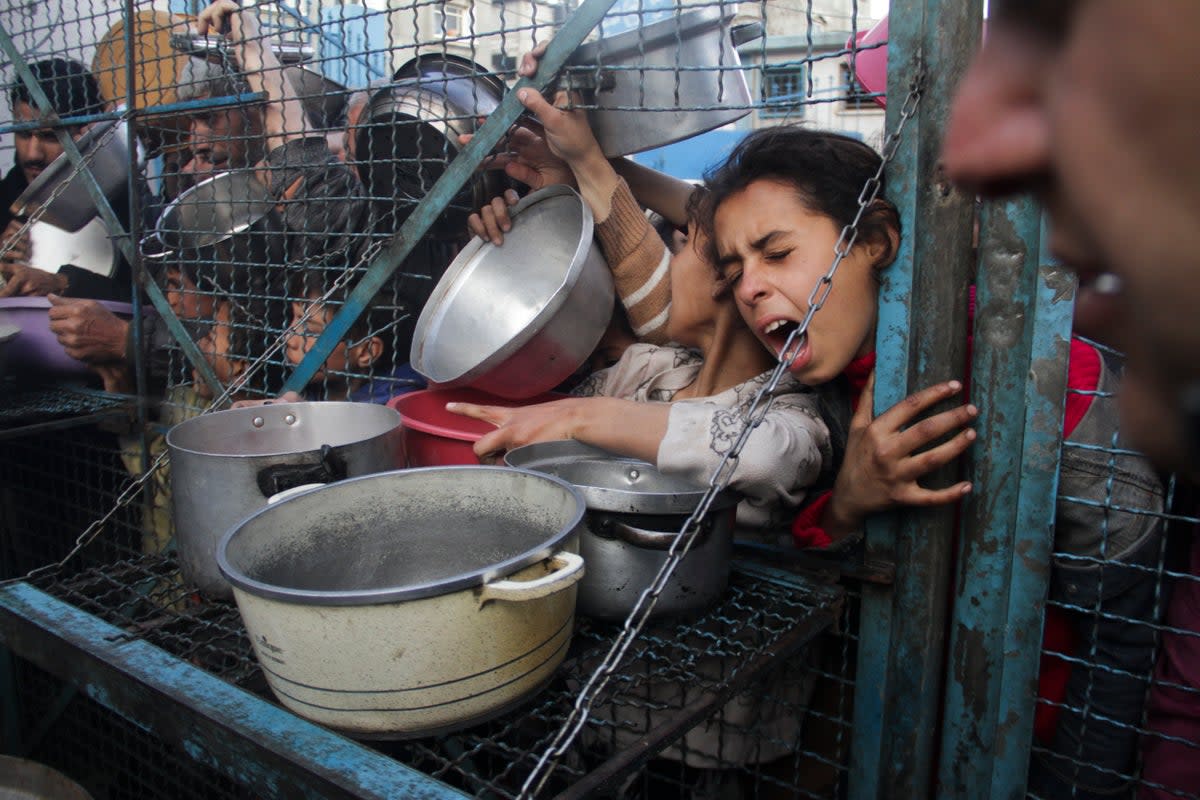
- Oops!Something went wrong.Please try again later.
President Joe Biden and his administration have been accused of being complicit in enabling a famine in Gaza by failing to sufficiently act on repeated warnings from their own experts and aid agencies.
Interviews with current and former US Agency for International Development (USAID) and State Department officials, aid agencies working in Gaza and internal USAID documents reveal that the administration rejected or ignored pleas to use its leverage to persuade its ally Israel – the recipient of billions of dollars of US military support – to allow sufficient humanitarian aid into Gaza to stop the famine taking hold.
The former officials say the US also provided diplomatic cover for Israel to create the conditions for famine by blocking international efforts to bring about a ceasefire or alleviate the crisis, making the delivery of aid almost impossible.
“This is not just turning a blind eye to the man-made starvation of an entire population, it is direct complicity,” former State Department official Josh Paul, who resigned over US support for the war, told The Independent.
Israel has vehemently denied that there is a hunger crisis in Gaza, or that it has restricted aid. It says fighting with Hamas, the militant group that triggered the current war when it killed 1,200 people and took over 250 hostages in Israel on 7 October, has hampered aid efforts.
As of the start of April at least 32 people, 28 of whom were children, have died of malnutrition and dehydration in Gaza, according to Human Rights Watch. The deaths of those children, and the likely many more to come, might have been prevented if president Biden had reacted more forcefully to concerns shared publicly and privately.
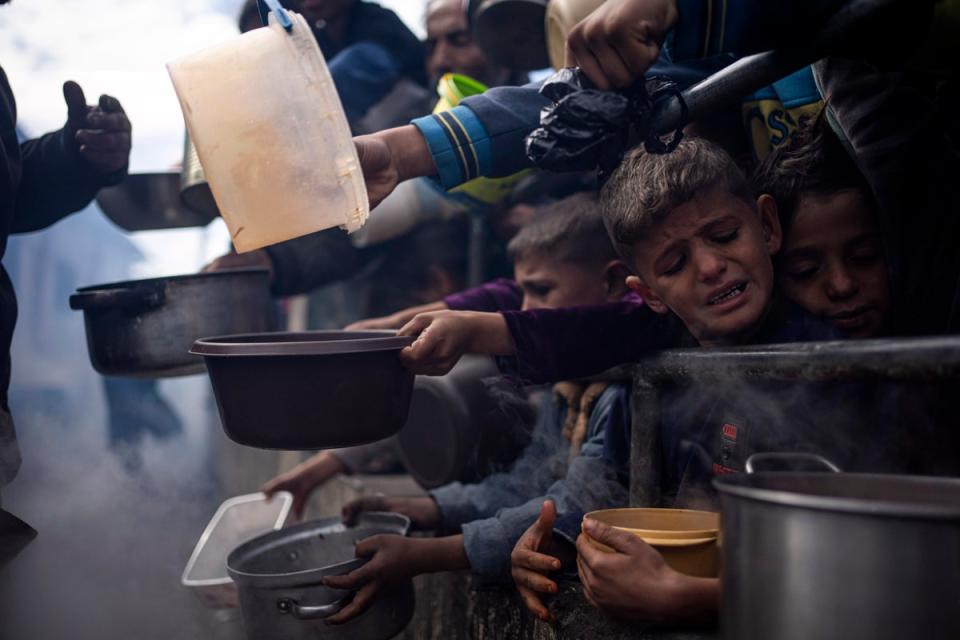
From the time of the first warning signs in December, intensive US pressure on Israel to open more land crossings and flood Gaza with aid could have stopped the crisis taking hold, the officials said. But Mr Biden refused to make US military aid to Israel conditional.
Instead, the Biden government pursued novel and ineffective aid solutions such as airdrops and a floating pier. Now, some 300,000 people in Gaza’s north are experiencing a “full-blown” famine, according to the World Food Programme, and the entire 2.3 million population of Gaza is experiencing catastrophic levels of hunger.
The level of dissent within the US government agency responsible for administering civilian foreign aid and combating global hunger has been unprecedented.
At least 19 internal dissent memos have been sent since the start of the war by staff at USAID criticising US support for the war in Gaza.
In an internal collective dissent memo drafted this month by numerous employees of USAID, the staff assail the agency and the Biden administration for its “failure to uphold international humanitarian principles and to adhere to its mandate to save lives”.
The leaked draft memo, seen by The Independent, calls for the administration to apply pressure to bring “an end to the Israeli siege that is causing famine”.
Not acting upon repeated warnings like these was a political choice.
“The US has provided both the military and the diplomatic support that enabled famine to emerge in Gaza,” Jeremy Konyndyk, a former high-ranking USAID official under both Barack Obama and Joe Biden who worked on famine prevention in Yemen and South Sudan, told The Independent.
This investigation chronicles the Biden administration’s repeated failures to act forcefully in response to months of warnings of a looming famine. Those failures continue to this day.
Children are the most at risk
Famine takes the youngest first. In Gaza today, many mothers cannot produce the milk needed to feed their babies because they do not have enough food to eat for themselves. People desperate for any sustenance are resorting to eating animal feed and boiling grass. Many families are living off one meal a day.
Arvind Das, team leader for the Gaza crisis at the International Rescue Committee who has spent months in Gaza, described seeing more severely malnourished children as the months went on.
“Now it’s the norm to see paper-thin children and women, with literally no flesh,” he said.
“I’ve seen children sitting in the corridors, infants and babies with no food, no proper drinking water, nothing. I have not seen that kind of severe malnourishment,” said Mr Das, a veteran humanitarian who has worked Syria, Sudan and South Sudan.
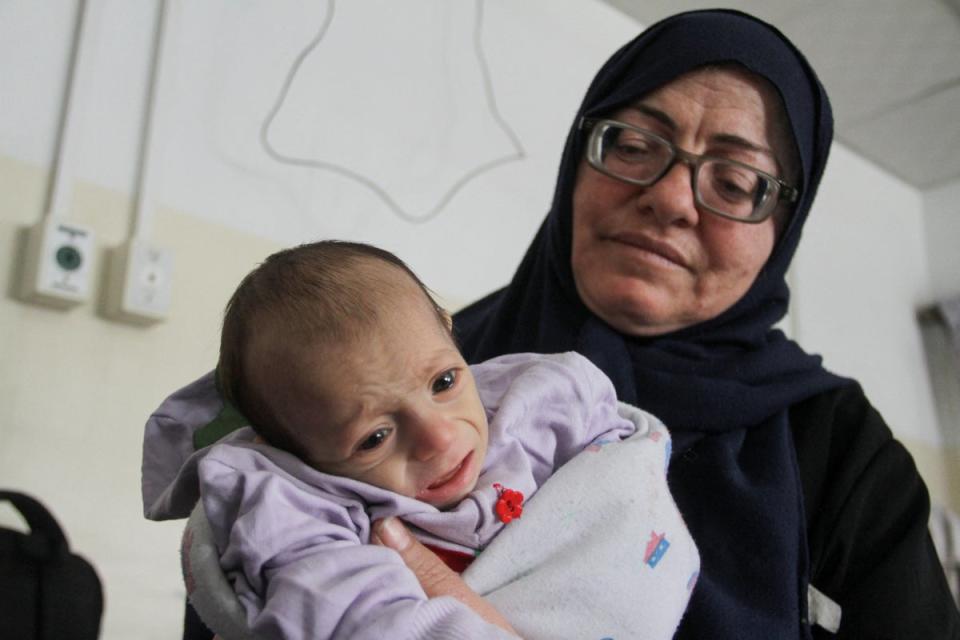
An emergency doctor from the UK working in a Gaza hospital near Khan Younis said over the phone that “children in particular are suffering massively”.
“We have children here at the age of 10 and 12 years old who have the weight of children aged four or five years old,” the doctor said. “There’s chronic malnourishment and malnutrition across most of the children – if not all of them – and it’s absolutely heartbreaking to see what’s happening to them.”
This deadly famine was foreshadowed in the first days of the war. Israel’s response to the brutal Hamas attack of 7 October began with a crippling blockade announced by defence minister Yoav Gallant.
“We are imposing a complete siege. No electricity, no food, no water, no fuel – everything is closed. We are fighting human animals and we must act accordingly,” he said on 9 October.
Those words would be followed by action.
Israel launched its most ferocious bombardment yet and a crippling siege on Gaza in retaliation for Hamas’s bloody attack. Since then Palestinian officials say Israel’s offensive has killed at least 35,000 people, most of them women and children.
Israel tightly restricted the delivery of aid into the strip from those first days onwards. UN officials and aid agencies told The Independent that exhaustive inspections of trucks, systemic limiting of deliveries and arbitrary refusal of entry of “dual-use” items such as trucks and supplies that Israel said could be used by Hamas in the war have exacerbated the hunger crisis in Gaza.
I believe the US to be complicit in creating the conditions for famine. Not only has our response been woefully inadequate, but we’re actively responsible in large part for it
USAID employee
Interviews with over a dozen UN officials, aid workers and diplomats coordinating aid revealed that there are also restrictions on the delivery of aid within Gaza, piling pressure on the north of the besieged strip. Fierce fighting and general insecurity across the strip all contributed further to the slowing of aid deliveries. On numerous occasions, people desperate for food swarmed aid trucks as they reached an affected area.
Some two-thirds of Gaza’s population were dependent on food aid before the war, and more than 500 trucks entered the territory each day, including fuel. Between 7 October and the end of February, the average number of trucks entering dropped to just 90 per day, an 82 per cent drop at a time when war made the need for aid much greater.
Israel vehemently denies there is a hunger crisis in Gaza, or that it has restricted aid. The defence ministry unit tasked with coordinating with the Palestinians, known as the Coordination of Government Activities in the Territories (COGAT), has repeatedly said there is “no limit” to the amount of aid going to Gaza which they “actively” facilitate. The Independent reached out to COGAT for comment on these specific claims and has yet to receive a reply.
Vital infrastructure necessary for food production was also destroyed by bombing. On 15 November, Gaza’s last remaining wheat mill was bombed and rendered inoperational – that meant no more flour, and no bread, other than whatever outside organisations could bring in.
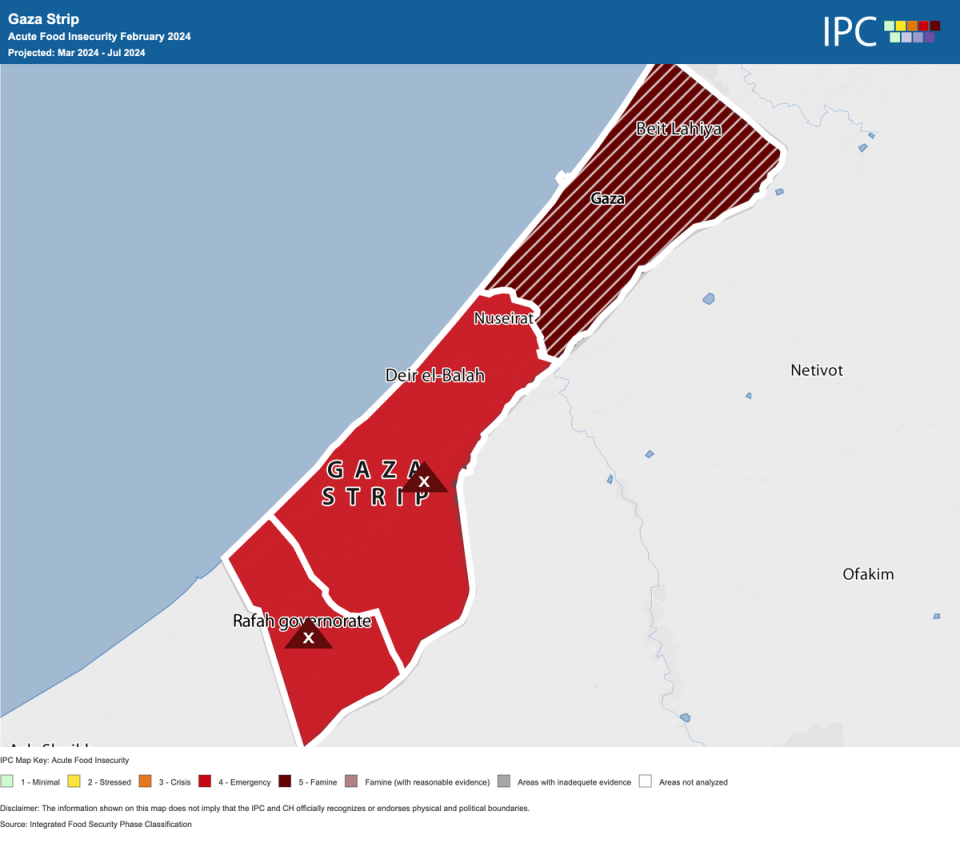
Israel’s extensive bombing across Gaza also made it nearly impossible to deliver aid safely anyway. At least 254 aid workers have been killed throughout the conflict, including 188 UN staff – representing the highest number of UN personnel killed in a conflict in the history of the organisation. Multiple aid convoys have come under Israeli fire. UNRWA, the UN’s Palestinian refugee agency, said that despite sharing GPS coordinates, the number of trucks and the contacts with the military, three of their aid convoys have been hit by Israeli naval artillery and gunfire.
The warnings begin
Casualties from Israel’s bombardment of Gaza quickly reached into the thousands, but the threat of starvation followed close behind.
By December, the two international institutions used by governments around the world to determine when famine is occurring – the Integrated Food Security Phase Classification and the Famine Early Warning Systems Network – had come to the same conclusion: famine was imminent, and threatened more than one million people.
Mr Konyndyk, who led USAID’s Office of Foreign Disaster Assistance for three years, said those warnings should have compelled the White House to act urgently. If the same conditions were appearing in most other countries in the world, he said, it would have. But the US had stubbornly refused to do anything that would hamper Israel’s war effort.
“When the warnings start signalling that risk, there should be a forceful reaction, both on the relief aid front and on the diplomatic front,” he said. “Nothing about the Biden administration’s response to the December famine forecast demonstrated that kind of hard pivot toward famine prevention.”
What followed was a pattern of defence, deflection and outright denial from the White House.
Under questioning from The Independent, Biden administration spokespersons have routinely highlighted Mr Biden’s repeated requests for the Israeli government to open up more crossings to aid, and pointed to temporary increases in aid trucks entering Gaza as proof of what they describe as his effectiveness.
What was left unsaid by those Biden aides was the fact that those piecemeal influxes of aid were not consummate to the scale of the crisis. Hunger continued to spread, and still the White House refused to use its leverage by threatening to condition military aid.
Nothing about the Biden administration’s response to the first famine report demonstrated that kind of hard pivot toward famine prevention
Jeremy Konyndyk, former director of USAID’s Office of US Foreign Disaster Assistance
“Behind the scenes, my impression is that the Biden administration was pushing Israel to resume opening crossings to aid. But it was this posture of pretty extensive deference to how Israel was choosing to fight the war, while continuing to supply it with arms and not putting any real conditions on that,” Mr Konyndyk said.
A spokesperson for the White House National Security Council said: “Since the beginning of this conflict, president Biden has been leading efforts to get humanitarian aid into Gaza to alleviate the suffering of innocent Palestinians who have nothing to do with Hamas.”
“Before the president’s engagement, there was no food, water, or medicine getting into Gaza. The United States is the largest provider of aid to the Gaza response. This is and will continue to be a top priority to address dire conditions on the ground since much more aid is needed,” the spokesperson added.
Inside USAID, career civil servants with extensive experience were horrified by the lack of urgency from their politically appointed leaders.
Internal USAID documents seen by The Independent showed that staff were passing their concerns about the lack of action up the chain to USAID administrator Samantha Power and other senior leaders in the form of letters and internal dissent memos, often to no avail.
“What was surprising to me, and deeply disappointing, was the fact that we were hearing nothing about imminent famine in Gaza,” said a USAID staffer, who asked to remain anonymous because they are still employed by the agency.
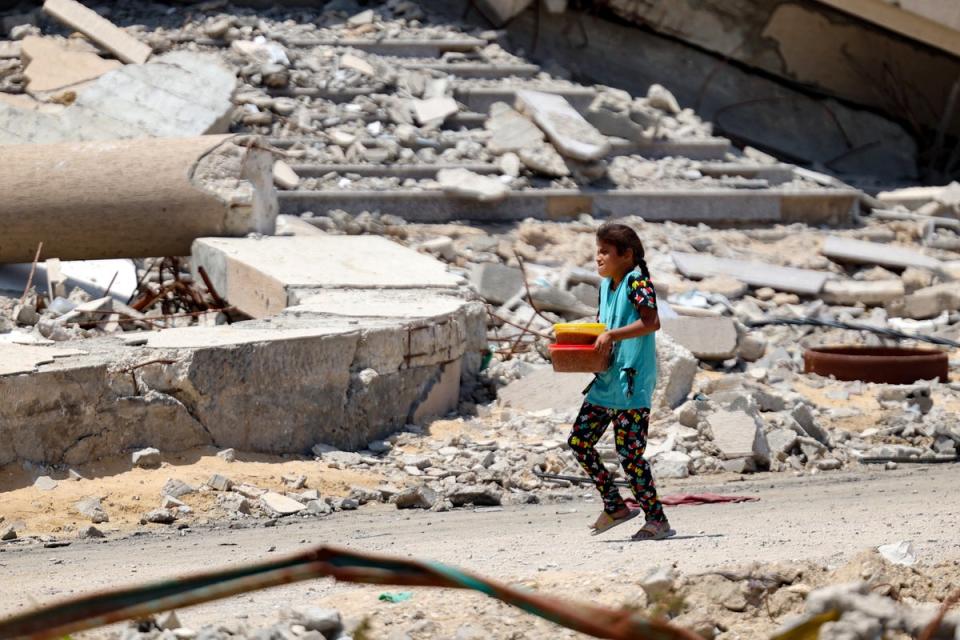
Dissent memos – a kind of sanctioned internal protest through a dedicated channel for offering critical feedback on policy – are relatively rare in USAID compared with the State Department. However, the USAID staff member said they were aware of at least 19 memoranda being sent in objection to the lack of action by the agency – and the government – over the looming famine.
Mr Konyndyk described it as “an extraordinary number,” and noted that he didn’t recall encountering a single dissent memo at USAID during his more than five years there under Mr Obama and Mr Biden.
A spokesperson for USAID told The Independent that the agency’s leadership “frequently meets with staff across the region and in Washington who understandably feel deeply about this conflict. This includes town halls with mission staff in the region, regular conversations and dialogue with our employee resource groups, and ongoing response meetings.”
“The expertise of our staff, many of whom have deep experiences in and connections to the region and the communities impacted by this conflict, shapes and informs our position as an Agency,” they added.
By mid-January, aid agencies on the ground in Gaza were issuing desperate pleas for a humanitarian ceasefire so that food supplies could be delivered. The United Nations Office for the Coordination of Humanitarian Affairs (OCHA) reported that 378,000 people in Gaza were facing catastrophic levels of hunger, and all 2.2 million people in Gaza were facing acute food insecurity.

“This is a population that is starving to death, this is a population that is being pushed to the brink,” the World Health Organisation’s emergencies director Michael Ryan said at a press conference on 31 January.
The same day Mr Ryan described Gaza’s grim outlook, White House national security communications adviser John Kirby defended the Biden administration’s decision to suspend aid to UNRWA. Mr Kirby denied that cutting off assistance to the UN entity with the largest footprint in Gaza would have a detrimental effect on the humanitarian situation there, and instead claimed that the US was “working so hard to get more [humanitarian] assistance into the people of Gaza”.
Even at this point, the White House was focused on giving Israel everything it needed to win its war against Hamas.
UNRWA loses ability to function
Hunger spread rapidly over the next month as the war raged on. On 27 February, three senior United Nations officials told a security council that at least 576,000 people were now “one step away from famine”.
“Unfortunately, as grim as the picture we see today is, there is every possibility for further deterioration,” Ramesh Rajasingham, director of UN’s OCHA, told the chamber.
In one of the most deadly massacres of the conflict, dozens of Palestinians desperately trying to access supplies were killed after Israeli troops fired on a crowd collecting flour from aid trucks on 29 February near Gaza City. The Israeli army initially blamed a stampede for the chaos, but in a later review claimed that Israeli forces “did not fire at the humanitarian convoy, but did fire at a number of suspects who approached the nearby forces and posed a threat to them.”
“During the course of the looting, incidents of significant harm to civilians occurred from the stampede and people being run over by the trucks,” the Israeli army review added. More than 100 Palestinians were killed trying to access aid that day.
Before the war, UNRWA, the largest UN agency working in Gaza, provided and distributed the basic necessities for people to survive in the blockaded territory, such as food, medicine and fuel. The US was by far the largest donor to UNRWA, contributing nearly half the agency’s yearly operating budget.
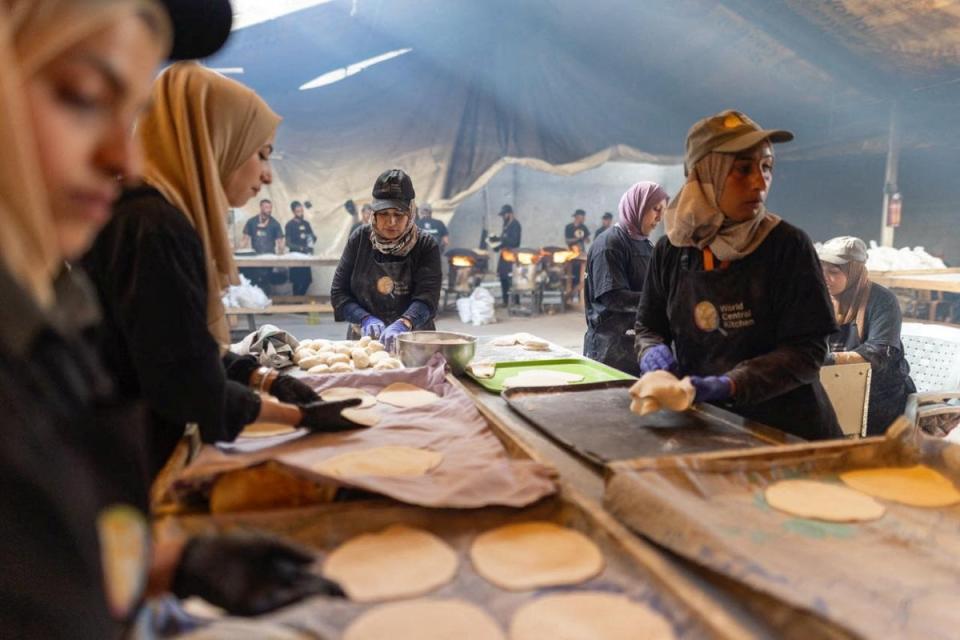
But the US suspended that funding following allegations by Israel that some 12 UNRWA employees were involved in the 7 October attack and around 10 per cent of its staff had ties to militants. (An independent review led by former French foreign minister Catherine Colonna later found that Israel has yet to provide any supporting evidence of these claims.)
By the end of February, UNRWA said Israel had effectively banned it from entering the north of Gaza.
At least 188 of its staff had been killed since the beginning of the war, more than 150 of its facilities were hit – among them many schools – and more than 400 people were killed “while seeking shelter under the UN flag”, the organisation said.
The killings had a severe impact on aid groups’ ability to deliver desperately needed supplies – and security conditions for aid workers continued to worsen. Following an attack on a food distribution centre in Rafah in March, UNRWA’s head Philippe Lazzarini accused Israel of a “blatant disregard” for international humanitarian law.
“Today’s attack on one of the very few remaining UNRWA distribution centres in the Gaza Strip comes as food supplies are running out, hunger is widespread and, in some areas, turning into famine,” he said, adding that the coordinates for the facility were shared with the Israeli army.
Mr Lazzarini frequently spoke out publicly against Israel blocking humanitarian aid convoys.
“I’ve said it many times: this is a man-made hunger and looming famine which can still be averted,” he said in March.
The Independent reached out to Israel’s COGAT for a response to these claims but has yet to receive a response. In previous statements COGAT has “vehemently” condemned what it called “false accusations that are being irresponsibly disseminated” that Israel restricts aid into or through Gaza. It also accused Hamas of hindering and stealing aid. COGAT also rejected accusations that there has been a decrease in the number of aid trucks entering the enclave.
“Israel assists, encourages and facilitates the entry of humanitarian aid for the residents of the Gaza Strip and for medical and other critical infrastructures in the Strip,” COGAT said, adding that Israel is at war with Hamas “not against the residents of the Gaza Strip”.
A simple solution
To humanitarians on the ground, the solution to the problem was simple: a ceasefire was the only way to surge the amount of aid needed to prevent a famine. Barring that, at the very least, Israel would need to open up more land crossings in Gaza and allow more aid trucks to enter.
But successive attempts to broker a ceasefire at the United Nations Security Council were blocked by the US on behalf of its ally, Israel.
Explaining the justification for a third veto on 20 February, US ambassador to the UN Linda Thomas-Greenfield said an immediate ceasefire would jeopardise multilateral talks to broker a pause in the war and the release of hostages held by Hamas.
In the absence of a wide-ranging ceasefire, humanitarian groups called on the Biden administration to use its leverage to pressure Israel to immediately allow a flood of aid into Gaza that would be necessary to stop the famine.
Only the US, as the primary backer of Israel’s war and the benefactor of its defence to the tune of $4bn a year, had the leverage to persuade Israel to do so. But Mr Biden had stubbornly refused to even consider conditioning aid, recalling his long-held belief in the importance of supporting the world’s only Jewish state.
Jan Egeland, the secretary-general of the Norwegian Refugee Council, a humanitarian organisation with dozens of aid workers operating in Gaza, said he had written to secretary of state Antony Blinken in October and urged him to create an international monitoring mission at Gaza’s borders to facilitate the delivery of aid, instead of leaving it in Israel’s hands while it fought a war. His appeals fell on deaf ears.
“The diplomatic impotence has been astounding,” he told The Independent. “Here are presidents and prime ministers travelling to [Israel] begging, urging appealing, and the answer is no. And then they just continue providing arms and support. Who are the great powers here?”
Mr Egeland said the US should have known what would happen to Gaza when Israeli leaders threatened massive destruction in the first days after the Hamas attack.
“They knew about it, they still didn’t condition their support. This was a major, a major mistake. And of course now that has spectacularly backfired,” he said.
Mr Paul said there was a “double standard when it comes to Israel” in the Biden administration – on everything from weapons to upholding international humanitarian law.
The administration had a host of tools at its disposal to press Israel to cease its aid restrictions, he added.
“The administration could have done so through the application of Section 620I of the Foreign Assistance Act, which prohibits assistance to countries restricting US-funded humanitarian assistance; it could have done so through the withholding of arms shipments; it could have done so by supporting resolutions at the UN calling on Israel to stop restricting humanitarian assistance,” he said.
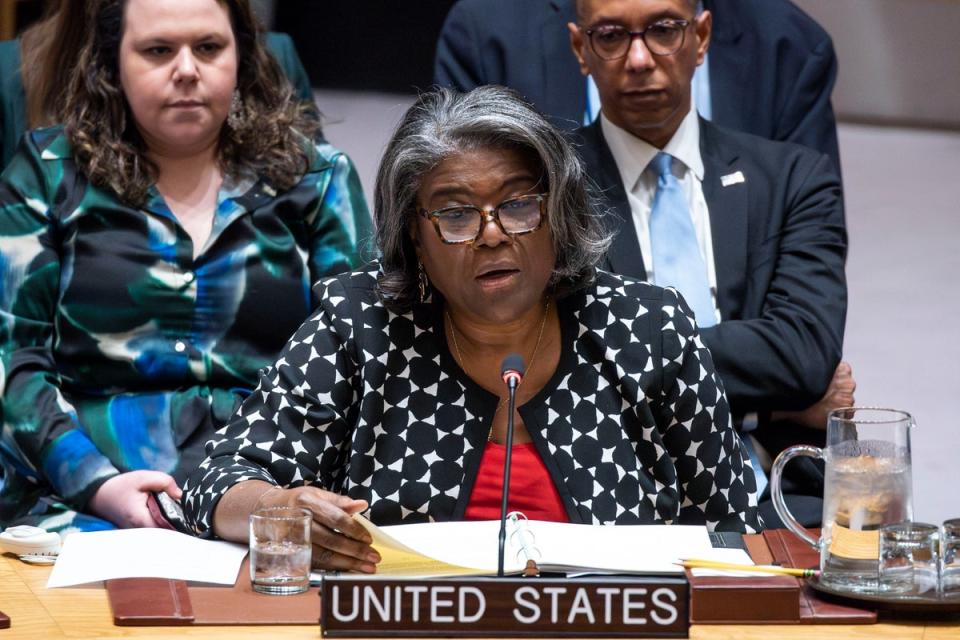
Mr Konyndyk, who is now president of Refugees International, made a public call in an opinion piece in February’s Foreign Affairs for Mr Biden to “act now to make famine prevention a top priority and be prepared to deploy meaningful US leverage – including pausing arms sales – if the Israeli government does not comply.”
Speaking to The Independent one month after its publication, he said that famine was likely inevitable without swift action from Mr Biden.
Within USAID, too, staff were angry at the Biden administration’s repeated assertions that it was doing all it could to push Israel to allow in more aid. The amount of aid that reached Gazans dropped by half in February compared to the previous month.
On 3 March, vice-president Kamala Harris made what was at the time the boldest declaration of the importance of humanitarian aid to Gaza. In remarks commemorating the anniversary of civil rights protests in Selma, Alabama, Ms Harris said Israel’s government had to “do more to significantly increase the flow of aid” and warned that there were “no excuses” for not doing so.
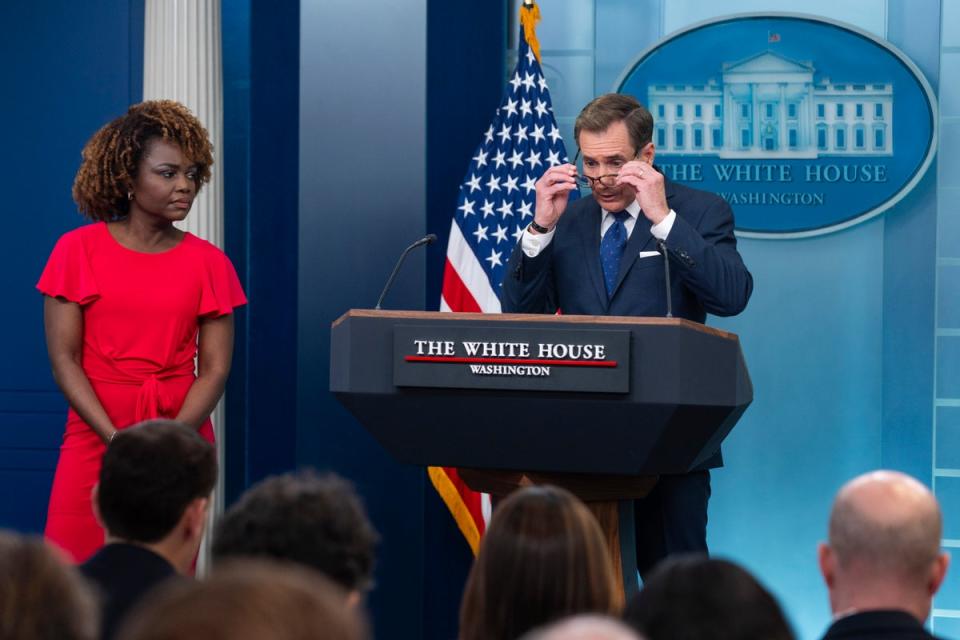
And days later, Mr Kirby, the White House spokesperson, told The Independent at a daily press briefing that it was “not acceptable” and “not the right thing for any purpose” for Israel to restrict aid deliveries into Gaza.
But Mr Kirby also categorically rejected the idea that Mr Biden should use the leverage of restricting weapons deliveries to force Israel’s government to allow aid to flow.
The USAID employee described the administration’s insistence that it was doing all it could to stop the spread of hunger as “very disingenuous”.
“I don’t believe that the President of the United States – Israel’s most important ally and benefactor – has so little leverage that he can’t force them to take meaningful steps to really allow in the amount of aid that is necessary to save lives,” they said.
“It feels like there was no real effort to force Israel’s hands, in terms of ensuring greater access to humanitarian assistance,” they added.
After failing to persuade its ally to allow more aid to enter via land crossings, the US took the unusual step of launching aid airdrops into Gaza.
Mr Konyndyk, who oversaw similar humanitarian airdrops to Nepal, the Philippines and Iraq, described the plan as a “major policy failure” on the part of the Biden administration.
Airdrops are “the most expensive and least effective way to get aid to a population. We almost never did it because it is such an in-extremis tool,” he said.
“When the US government has to use tactics that it otherwise used to circumvent the Soviets in Berlin and circumvent Isis in Syria and Iraq, that should prompt some really hard questions about the state of US policy,” he said.
Biden finally takes action
On 2 April, the danger for those trying to deliver food to desperate Gazans was thrown into sharp relief yet again. A group of international aid workers with the World Central Kitchen (WCK) were killed by three successive Israeli drone strikes in Gaza.
The non-profit humanitarian aid organisation founded by celebrity chef José Andrés said their members were travelling in cars branded with the charity’s logo when they were hit, despite coordinating their movements with the Israeli military.
In an opinion piece headlined “Let People Eat” published in The New York Times in the days after the killings, Mr Andrés said the strike was “the direct result of a policy that squeezed humanitarian aid to desperate levels”, and accused Israel of “blocking food and medicine to civilians”.
The reaction from the White House was different this time. Mr Andrés is a friend of Mr Biden, and a popular figure in Washington DC. For the first time in the conflict, the president raised the prospect that the US might withhold its support if Israel did not immediately take certain actions.
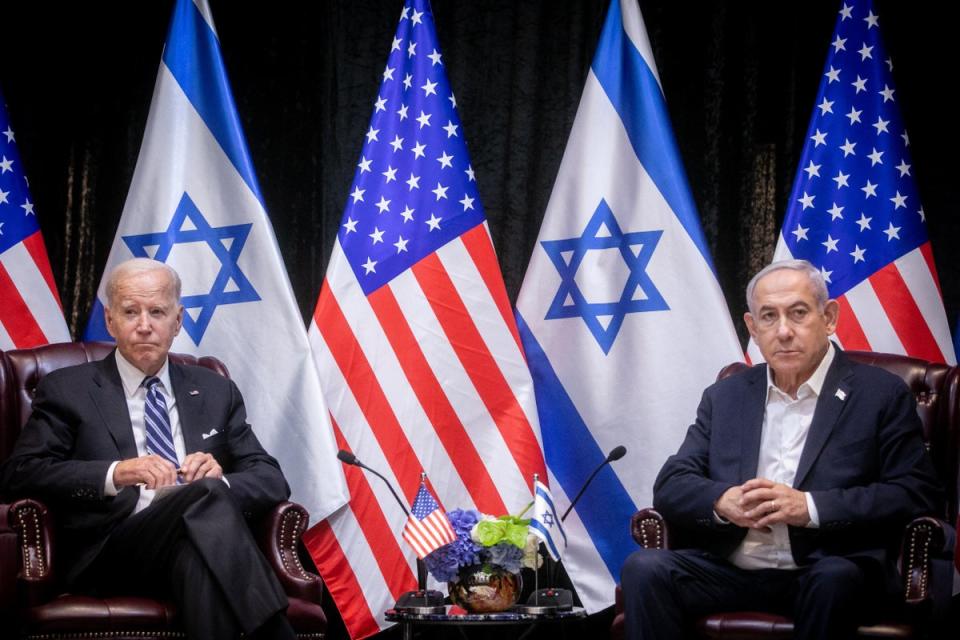
In a call with Israeli prime minister Benjamin Netanyahu two days after the WCK killings, Mr Biden “made clear the need for Israel to announce and implement a series of specific, concrete, and measurable steps to address civilian harm, humanitarian suffering, and the safety of aid workers”, according to a White House readout of the call.
The Israeli government responded immediately by approving the opening of three humanitarian aid corridors into Gaza, including the Erez Crossing in northern Gaza, which had not been open since the start of the conflict.
Still, the calls from aid organisations were becoming ever-more alarming. A Human Rights Watch report published on 9 April accused Israel of “the continued commission of the war crimes of collective punishment, deliberate obstruction of humanitarian aid and using starvation of civilians as a weapon of war.”
At the same time, USAID officials were becoming more forceful in sounding the alarm internally.
A cable drafted by officials at the agency and leaked to HuffPost in early April said that “the threshold to support a famine determination has likely already been crossed,” and that the level of hunger and malnutrition in Gaza was “unprecedented in modern history”.
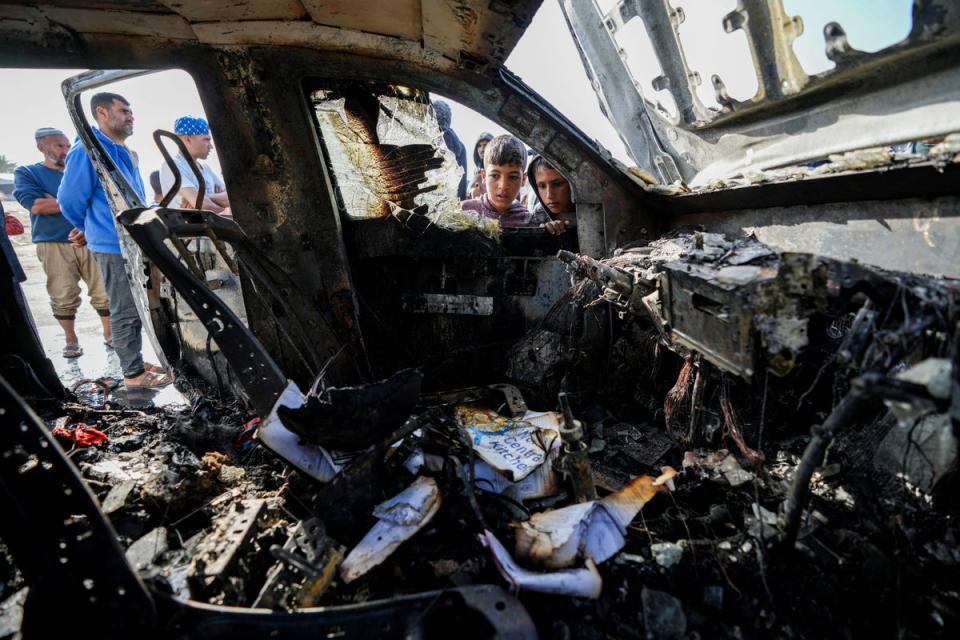
A separate memo written by USAID officials for Mr Blinken and leaked to Devex found that Israel may be violating a White House directive requiring recipients of US military assistance to permit the unimpeded delivery of US-funded humanitarian support.
Yet another memo leaked to Devex by food security experts was titled “Famine Inevitable, Changes Could Reduce but Not Stop Widespread Civilian Deaths.” It said that “Israel-imposed administrative challenges are preventing the delivery” of lifesaving humanitarian assistance.
Mr Biden’s pressure on Mr Netanyahu appeared to have an immediate effect. More trucks carrying food and supplies were able to get into Gaza in late April, and Israel finally opened the Erez crossing on 1 May, leading to the entry of more than 200 trucks per day for several weeks.
For some, it was a sign of progress. But for others, it showed that Mr Biden had the power to have a direct impact on Israel’s actions whenever it chose to use its leverage.
But as had happened several times throughout the conflict, the pressure and the progress were short-lived.
A famine wasn’t inevitable
The UN has said repeatedly that, by the time an official declaration of famine is made, it will be too late to prevent thousands of deaths. The declaration requires a painfully precise collection of data that is not possible to get while the north of Gaza remains cut off by the fighting.
It was likely with that in mind that Cindy McCain, the US director of the UN World Food Programme, became the most prominent international official so far to declare a famine in northern Gaza last weekend.
“It’s horror”, McCain, widow of Biden’s close friend, former Senator John McCain, told NBC’s Meet the Press in an interview that aired 5 May. “There is famine – full-blown famine – in the north, and it’s moving its way south.”
To the humanitarian groups working on the ground, this was not an inevitable conclusion.
“This is an entirely preventable, human-made famine caused by lack of humanitarian aid and humanitarian access restrictions over seven months,” said Louise Wateridge, communications officer with UNRWA, in a phone interview from Gaza last week.
According to UN figures, more than half of Gaza’s population– some 1.1 million people – face catastrophic food insecurity. This represents the highest share of a population ever recorded globally. One in three children under the age of two suffer from acute malnutrition.
It is about to get worse.
Israel had for some months now publicly announced its intention to invade the southern city of Rafah, the last refugee camp in Gaza which is sheltering more than one million people displaced from elsewhere across the destroyed territory. Among that number are around 600,000 children packed into tents, crowded buildings and hospital courtyards with little more than tarpaulin to hide under. The city is the main hub for aid agencies operating in Gaza, and according to Israel, the last remaining stronghold of Hamas. The White House had previously expressed its public opposition to a full-scale operation in Rafah, given the humanitarian disaster it would inevitably cause.
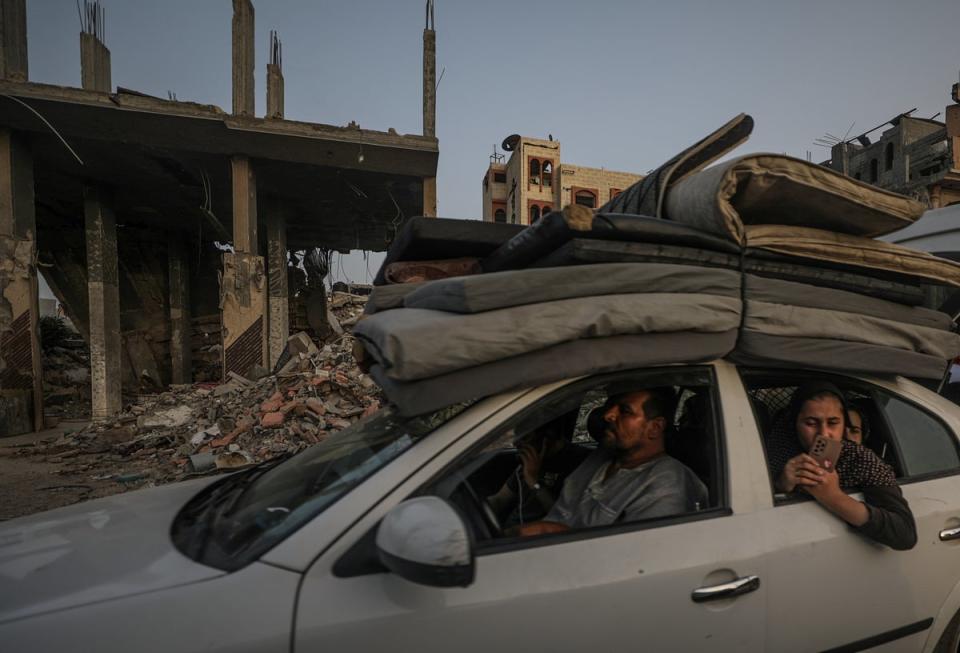
But just days after Ms McCain’s interview, Israel issued an evacuation order for 100,000 people in the city. On 7 May, Israeli forces captured the Rafah border crossing, halting the transfer of aid through what was a major conduit. It is also the only crossing wounded or sick Palestinians can evacuate through.
It also closed another crucial crossing, Kerem Shalom, after an attack two days earlier killed four soldiers in the area. While Israel says Kerem Shalom has since reopened, UN officials said it is too dangerous for humanitarians to properly access. Jens Laerke, spokesperson for OCHA said that Rafah and Kerem Shalom were “main arteries of the humanitarian operation” for the entire strip and that their closure has been “catastrophic”.
The move prompted a dramatic response from Mr Biden. For the first time, he threatened to pause the delivery of certain offensive weapons to Israel if its defence forces entered the city proper. Rather than dialling back their offensive, Israel widened the evacuation orders in the south and north of Gaza to affect an estimated 300,000 people and began its assault on Rafah.
Meanwhile, the president has not placed the same conditions on the delivery of much-needed aid.
It is that discrepancy that has caused so much consternation within the US government, especially among those whose job it is to prevent people from dying of hunger.
“I believe the US to be complicit in creating the conditions for famine,” the current anonymous USAID employee told The Independent. “Not only has our response been woefully inadequate, but we’re actively responsible in large part for it.”

